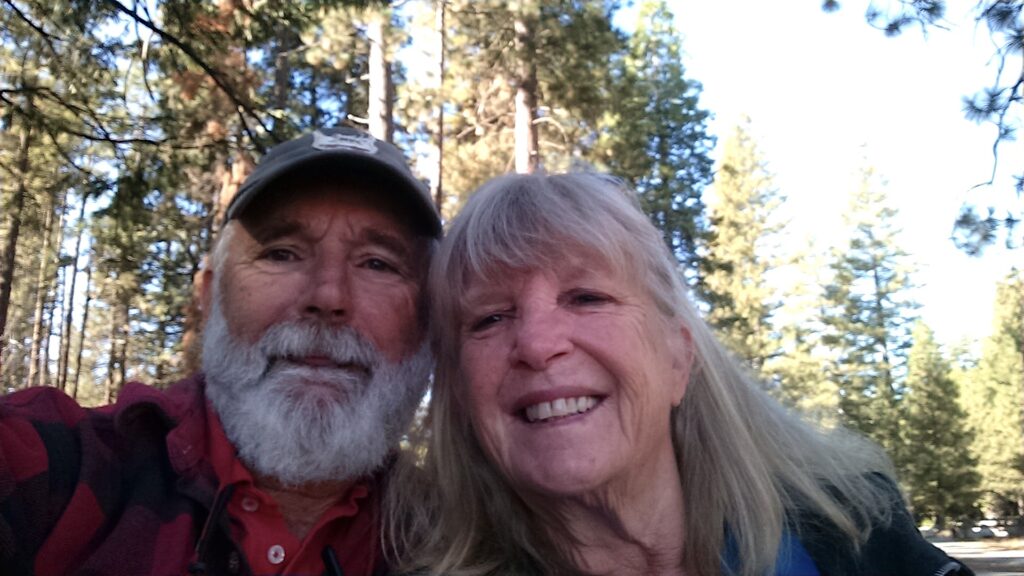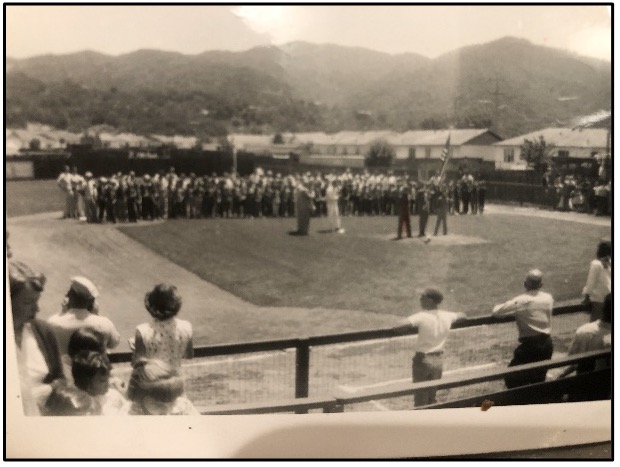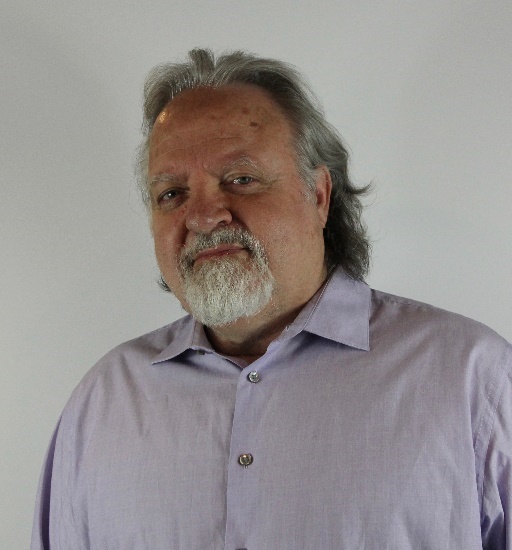
Chuck & Marilyn
von Schalscha
By Bonnie Monte
Chuck and Marilyn are delighted that so many young families are moving to Santa Venetia. And Chuck certainly remembers when the neighborhood overflowed with kids back in the 1950s because he grew up in the very house on Vendola that he and Marilyn now live in. “My parents were the original owners,” he says. “Back then, there was nothing across from us. I could see all the way to Buck’s Landing.”
Marilyn moved with her family to San Rafael from Syracuse as a young girl because of her dad’s job with Fairchild, where he was one of the inventors of the LED! The two met at Terra Linda High and began dating when they were both students at College of Marin. They got married in 1969.
When Chuck was in the military, they moved to Sacramento, where they raised their son and daughter. They’ve also lived in Mexico for a season after sailing there, as well as in Pt. Richmond, but moved back to Marin to take care of their aging parents. “Marin has always felt like home to us,” says Marilyn.
Chuck’s dad loved boats, and apparently that fondness is in Chuck’s DNA because he and Marilyn own five vessels. Four are at their home and one is kept at the Richmond Yacht Club. Impressively, Chuck sailed solo to Hawaii in 1988. “That was before GPS,” he reminds me. Navigation was by sextant. There was no email back then either, Marilyn adds. She had no way to check in with her husband during his journey. But she and the kids were on shore in Hawaii to greet him as he sailed in.
Marilyn and Chuck are both active in CERT, working to make the neighborhood disaster-ready. As a ham radio operator, Chuck selected the hand-held radios that all the members have so they can stay in touch in an emergency. He also installed the solar power for the CERT trailer, while Marilyn keeps the trailer stocked with supplies. Practicing simulations of emergencies keeps the CERT team on their toes.
Drawing on her past training in computer programming, Marilyn has been working with Linda Levey to revamp the SVNA website, with plenty of old photos, a more robust archive of past newsletters, and easier navigation. “It’s been fun to use my brain to do that kind of stuff again,” she says. Keep an eye out for the new site, which should be up and running any day now.

Pat Fedorchak
By Bonnie Monte
One of the things worth cherishing about Santa Venetia is the presence of residents who have been here for the long haul. Pat Fedorchak is one of them, having lived in her home on Galerita since 1953. She, her husband John, and their two young children moved in when Pat was expecting their third child.
Born and raised in San Francisco, Pat met her sailor husband in 1943, and they married two years later. It was actually her parents who saw the new subdivision and fell in love with the place. Pat recalls her first look at Santa Venetia: eucalyptus trees right in the middle of North San Pedro Road, and a glimpse of a cow giving birth. “It was a brand-new neighborhood,” Pat recalls. “The street was still unfinished, with our house the last at the end of a row.” Houses beyond theirs were still to be built. Across the canal was a dairy farm. “At low tide, cows would meander over into our backyard.”
Tweedies, an all-purpose store, stood where the 7-Eleven is now. Vendors selling everything from baked goods to redwood outdoor furniture came door to door, and there were home deliveries of dairy products from Lucas Valley and Roberts Dairies. “It made shopping easy because most families had only one car, which the husband used. It was hard to get to stores,” Pat says. Later, there was a retail area where the homes on Adrian Terrace are now. “We used to have a big barbecue over there,” she says. She ticks off the long-gone businesses: “Littleman’s was a grocery store — they were a big chain in San Francisco. There was a gas station, a pharmacy, a jewelry store, a dentist, a sandwich shop, a dance studio.”
A popular beauty salon was up on the hill. On N. San Pedro Road was Mrs. Fenton’s nursery, which later became Tanem’s Garden Center. There was a yachting club on the canal. And across the water was a drive-in movie. Pat belonged to the Scabo Tennis Club, where she spent a lot of time on the courts. She was also a member of the Gallinas Village Improvement Association, which eventually morphed into the Santa Venetia Neighborhood Association.

Santa Venetia was filled with young families back then, Pat says. “Everyone had kids, and
they all knew each other. Sports were a big deal.” Pat’s husband managed their son’s Little League team at Castro Field. Pony League was in a field near the president streets, back before the Civic Center was built. Her kids walked to McPhail’s School and to the junior high that’s now Venetia Valley School. “It was a wonderful neighborhood.” Pat’s youngest daughter Tina, who now lives with her, concurs. “It was a great Little League, Opening Day, Late 1950’s place to grow up.” Although the neighborhood has changed a lot over the decades, says.
Mark Rappaport

By Bonnie Monte
If you’ve ever seen True Grit, The Revenant, or The Last Samurai, you’ve seen some of Mark Rappaport’s handiwork. He’s the founder of Creature Effects, a special effects studio in Los Angeles that produces animatronics for film and TV.
Mark was born in Japan and grew up in Napa. He recalls being a less-than-stellar student in high school and at San Diego State, despite working hard. After trying his hand at dozens of jobs – including baker, lifeguard, sailing instructor, cruise ship bar piccolo, fireman, deputy sheriff for Alameda County, and guard at San Quentin – he discovered his passion almost by accident.
In 1988 he was delivering the Sunday New York Times at 6 am, when he happened upon a group of people spray-painting monsters in an industrial area of San Rafael. Mark stopped and told the crew, “I’d like to do this too.” He was hired on the spot. And so began his love affair with model making and puppeteering.
After moving to Los Angeles, he honed his craft at a variety of special effects studios. “L.A. was so busy back then, even if I made a stupid mistake people still hired me,” he recalls. “I learned from people who were good.” Mark went on to found Creature Effects, known for their remarkably lifelike horses that mimic the motions of real animals. Not only is the use of animatronic horses much safer for the cast during stunt work such as falling, it’s also kinder to the horses. Mark pioneered the use of synthetic fur rather than actual horse skin, using an intricate process to affix the fibers to the fabric. “Horses on set don’t like getting near a dead horse,” he explains.
The studio also creates animatronic babies, a boon to filmmakers since real babies don’t always cooperate, and their allowable time on set is only 20 minutes. Mark perfected controls that make the babies’ movements much more lifelike than in the past.
As a result of his many technical innovations, Creature Effects received a Technical Achievement Award in 2017 from the Academy of Motion Picture Arts and Sciences.
After a career traveling all over the world and working with everyone from Tom Cruise to Harrison Ford to Leonardo de Caprio, Mark sold the studio to two of his employees. “I was negotiating with a company in China, but it would have meant that all the employees would be fired.” The deal he landed on meant less money, “but I can feel good about it,” he says.
He’s also working on a curriculum to be taught at his old high school in Napa that encourages students to focus on what they want to do as a career and be open to possibilities. Mark, who lives with his wife in the hills of Santa Venetia, is modest about his many successes. “I always hired people better than me,” he says.
